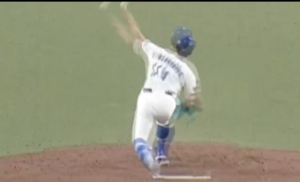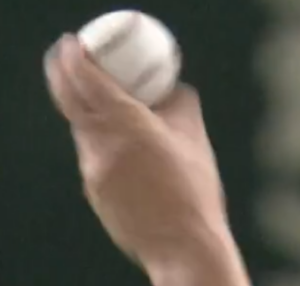Shinnosuke Ogasawara requested that the Chunichi Dragons post him this offseason after nine seasons with the club and the team obliged. He’s still a free agent, available for any MLB team to pursue.
Ogasawara, once considered a top prospect in NPB, has had up-and-down results for the Dragons but has shown glimmers of promise as a stocky lefty. I saw almost all of his starts from the last two seasons and this is my scouting report for him.
In sum: Ogasawara projects as a swingman or spot starter in MLB but will get the opportunity, as a strike-throwing lefty, to compete for a rotation spot.
Ogasawara’s Recent Seasons (2022-2024)
| Season | IP | ERA | ERA+ | K-BB |
| 2022 | 146.2 | 2.76 | 111 | 142-39 |
| 2023 | 160.2 | 3.59 | 82 | 134-41 |
| 2024 | 156.2 | 3.12 | 88 | 82-22 |
Ogasawara is 5’11’’ and 185 pounds with a strong lower half. He is similar in build to Shota Imanaga. While some might want to compare the two Japanese lefties, the gap between Ogasawara’s stuff and Imanaga’s is significant. He’s more Kolby Allard than Imanaga. Though Imanaga and Ogasawara both have high IVB (induced vertical break) lower-slot fastballs, Ogasawara’s secondary pitches and command lag behind Imanaga’s.
Ogasawara did post a slightly higher K% than Imanaga in 2022, with a 24% strikeout rate to Imanaga’s 23.6%. He has not captured that type of swing-and-miss production since, dropping to 20% in 2023 and 14% this past season.
And note that while ERAs of 3.59 and 3.12 the last two seasons may not look bad, context matters. He had a below-average ERA+, as NPB’s deader baseball keeps ERAs low.
Biggest Strength?
Ogasawara possesses above-average control and sprays the zone with his pitches. He mixes speeds well with his six- to seven-pitch arsenal, though he really focuses on just four pitches, with three of those secondaries.
He uses his four-seam about 50% and splits the rest of his usage between his knuckle curve, changeup, and slider – with less usage of his changeup against right-handed hitters.
Since he possesses fringe-average stuff throughout most of his arsenal, Ogasawara must pound the zone with first-pitch strikes and mix speeds.
Mechanics
Ogasawara has dabbled with a rhythmic foot move at points in the last two seasons, but he primarily throws out of the stretch. Starting with his glove at his belt, he raises it to his hat brim. He pulls the ball out of his glove with a tiny tap back into the mitt during his initial move forward.
Pushing his hip towards the plate, he stays closed down the mound, Ogasawara uncoils his energy as he shows the bottom of his cleat into front foot strike. Landing in a solid power position, he uses his lower half to drive energy through his lead leg block.
He’s under control and will vary his finish now and then, but he usually lands in a similar position ready to field. Ogasawara throws with tempo and timing more in mind than aggressively transferring energy into his delivery. His timing and sequencing create consistency and repeatability in his mechanics. He will also vary his arm angle, dropping it slightly in a given at-bat.

Pitch Velocity (MPH):
| Pitch | 2024 | 2023 |
| Fastball | 89 MPH | 90 MPH |
| Knuckle Curve | 70 MPH | 73 MPH |
| Changeup | 78 MPH | 83 MPH |
| Slider | 79 MPH | 79 MPH |
| Splitter | 82 MPH | 81 MPH |
| Hard Slider/ Cutter | 84 MPH | 84 MPH |
Pitch Usage:
| Pitch | RHB: 2024 (2023) | LHB: 2024 (2023) |
| Fastball | 48% (49%) | 54% (55%) |
| Knuckle Curve | 17% (21%) | 17% (21%) |
| Changeup | 24% (25%) | 4% (8%) |
| Slider | 5% (5%) | 23% (15%) |
| Splitter | 5% (<1%) | 1% (<1%) |
The Arsenal (2024 usage and Average Velocity)
Fastball 52%, 89 mph CSW% 26% Strike% 75%
Ogasawara features a high-ride, low-slot fastball though it lacks Imanaga’s 2023 specs in NPB. The two fit the same mold in terms of usage though. Ogasawara throwing over 50% four-seam is unsurprising given the spin and IVB around 19 inches with an NPB ball from a lower slot. The problem is that the two ticks in velocity Imanaga has on him are vital. Thus, Ogasawara’s fastball command must be cleaner to attack the zone.
In 2024, Ogasawara sprayed his fastball locations more than in 2023, when he was more glove-side with his command. The heat maps from this NPB Pitch Profiler show how spray-heavy his entire arsenal was in 2024.
Ogaswara sprinkled in a few sinkers with 3 percent usage in 2023, although he basically scrapped the pitch in 2024. He may need to throw the pitch more often in MLB given the sheer velocity of his fastballs; he needs a change in movement between his four-seam and two-seam. Ultimately, he will likely shrink his four-seam usage in MLB, mixing speeds even more. When he does throw his fastball, he will need to stay out of the middle of the plate and get over the top of the ball to drive it to his glove side more.
Knuckle Curve 17%, 70 mph CSW% 32% Strike% 58%
Ogasawara’s slow and loopy knuckle curve is not impressive in velocity or stuff metrics but it is a vital pitch to his arsenal. He needs the slow knuckle curve as a change of pace for his fastball, to survive being in the zone as much as he is.
Ogasawara utilizes it around 20% of the time on the first pitch to steal strikes and keep hitters honest. While he might drop its usage in MLB, around 15% usage will be important for Ogasawara since he lacks a whiff-pitch glove side.
2023 Count Usage
| PITCH | 1st Pitch Usage | 2-Strike Usage |
| Fastball | 53% | 47% |
| Knuckle Curve | 21% | 30% |
| Changeup | 13% | 15% |
| Slider | 11% | 6% |
| Splitter | 1% | 2% |
| Harder Slider/Cutter | 1% | – |
2024 Pitch Usage
| PITCH | 1st Pitch Usage | 2-Strike Usage |
| Fastball | 52% | 45% |
| Knuckle Curve | 20% | 18% |
| Changeup | 14% | 15% |
| Slider | 11% | 13% |
| Splitter | 2% | 9% |
| Harder Slider/Cutter | 1% | — |
As seen in the count usage charts above, Ogasawara’s big drop from 2023 to 2024 in two-strike counts was in his use of his knuckle curve late in the count. His two-strike knuckle curve usage plummeted from 30% to 18% between the last two seasons. His curve did provide relief in a high ground-ball rate at 70% in 2024.
Ogaswara’s curveball has a loopy quality causing batters to swing over the top and pound it in the dirt, because of the velocity differential and mixing speeds rather than pure pitch shape. He also locates the curveball below the zone leading to more grounders.
Ogasawara must avoid doubling up on the pitch. If he does, location will be key. These back-to-back curves to Munetaka Murakami display poor location on consecutive pitches.
Changeup 16%, 78 mph CSW% 34% Strike% 70%
Ogasawara’s changeup and splitter are his two best pitches. Ogasawara leans heavily on his changeup to righties, throwing it around a quarter of the time the last two seasons. He throws the pitch as more of a straight change with a tiny amount of fade. Throwing it with a two-seam grip he’s able to sink it down and away from right-handed hitters.
His catcher doesn’t just sit on the outside corner either. There are a lot of times when Ogasawara’s catcher will set up more in the middle of the zone and will try to sink the change below the zone off of a knuckle curve that was middled or a pitch that looks juicy as a middle fastball.
Splitter 3%, 82 mph CSW% 34% Strike% 63%
Ogasawara’s splitter is his most intriguing pitch because its characteristics make it a slightly harder offspeed pitch than his changeup. The two pitches will overlap in velocity, though, and the splitter has more sidespin than the backspin of his two-seam change.
The small percentage of pitches he has thrown creates a cause for concern if he can consistently command the pitch and even zone the splitter. There is way more comfort in throwing the changeup with his three-fingered grip rather than the splitter, where he’s splitting more across the horseshoe. His middle finger is not stabilizing in the middle of the ball with his splitter grip.
Finding more consistency in throwing his splitter and even constant velocity separation could help Ogasawara drop his fastball usage and throw more offspeed. Having an offspeed around 84 mph with a slower one around 79-80 mph could be a valuable weapon for a pitcher who doesn’t have much going for him stuff-wise.
Slider 13%, 79 mph CSW% 34% Strike% 57%
Ogasawara throws a sweeper with a two-seam grip and it hovers in the upper 70s in velocity; it’s an average pitch, in shape and velocity.
Living in the glove-side shadow zone, Ogasawara tries to nail the bottom corner at the knees against righties but also pushes the locations more thigh and belt high with the pitch. Ogasawara exclusively throws the pitch away from left-handed hitters, using the sweep he gets on the pitch as a contact suppressor rather than a strikeout pitch. Though he generates some whiffs on the pitch, he throws it late in counts as a putaway pitch.

In MLB, Ogasawara’s slider will need either refinement in his sweeper shape or he could add a harder cutter or slider-type pitch. In fact, Ogasawara threw a rare glove-side breaking ball that was about 84 mph and resembled a cutter-like shape. He throws it with a four-seam grip on the outer side of the ball but he tries to pull down on the top seam heavily. A team could push the harder breaking pitch alongside his sweeper to get more usage out of a pitch other than his four-seam and knuckle curve.
MLB Projection and Future
Ogasawara has been a steady performer in NPB since making his debut as an 18-year-old, providing solid yet unspectacular production in Chunichi’s rotation. With lesser velocity and more average to fringe-average pitches, Ogasawara’s control of the zone and mixing of speeds gives him a fighting chance at production stateside.
In 2022 he got more strikeouts and whiffs, but since then he has not been able to bottle that recipe of success with more of a contact-minimizing and grounders formula the past two seasons. As I noted atop the article, Ogasawara projects as a swingman or spot starter in MLB but will get the opportunity, as a strike-throwing lefty, to compete for a rotation spot.
His signing with a team might hinge on his promises of starting opportunities, though with his ability to mix speeds and change pace in at-bats, he could be successful in a more prominent bullpen role.
MLB comparison: Kolby Allard

